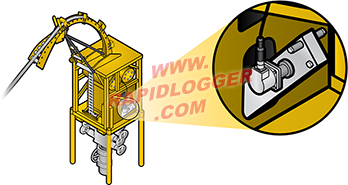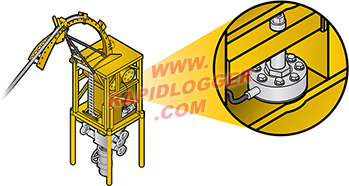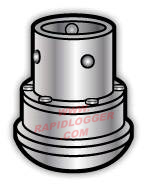The parameters that need to be measured on a coiled tubing job include depth, tubing weight, pump rate, circulating pressure, and wellhead pressure. For complex jobs other additional parameters may also be monitored and measured.
Depth is an important parameter to measure on a coiled tubing unit. It is measured by running a friction or counting wheel against the tubing surface as the CT is run in or out of the hole. Usually a chain and sprocket mechanism attached to this friction wheel is used to rotate the shaft of an encoder. This way for every turn of the friction wheel the encoder turns a known number of turns. In order to calculate the measured depth from the pulses counted by the encoder the following are required: The circumference of the friction wheel, the gear ratio of the chain and sprocket arrangement, and the number of pulses per rotation of the encoder. Measurement of depth and CT speed and its associated calculations is done automatically by most modern data acquisition systems such as the Rapidlogger.

Tubing weight, (sometimes called hanging weight, or Coiled Tubing tension) is another very important parameter to measure for a coiled tubing job.
Tubing weight is measured by means of a load cell. The coiled tubing injector head is built such that it is hinged on one side and on the other side its weight sits on a load cell. This hinge acts as a lever. In various injector head designs various lever lengths are used and thus ratio of the coiled tubing weight and weight seen by the load cell vary from design to design. The most common ratios are (4:1, 2:1, and 1:1). In some cases a double acting load cell is used. It can measure both compression and tension. Thus if the wellhead pressure is high and the coiled tubing has to be snubbed in to the well then the coiled tubing is in compression and this too can be measured. A modern data acquisition system such as the Rapidlogger can perform these calculations automatically and help prevent problems during job operations.

The proppant used in the fracturing fluids is extremely abrasive and erodes the walls of the pipe that it is flowing through. It also damages any sensors installed in the pipe. For this reason the measurement of fracturing fluid density or proppant concentration for a fracturing job is almost always done by means of a non contacting densitometer. A radioactive densitometer is one such device that works best. The Rapidlogger data acquisition has a built in mode for efficiently setting up and recording oilfield fracturing jobs.
